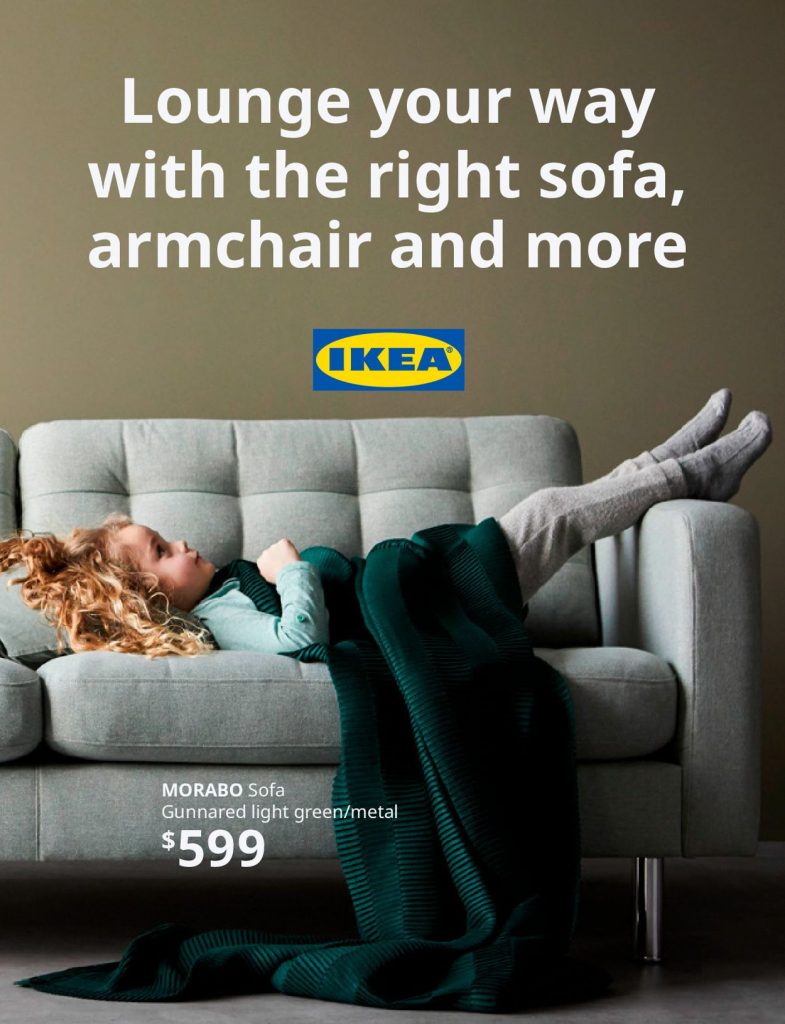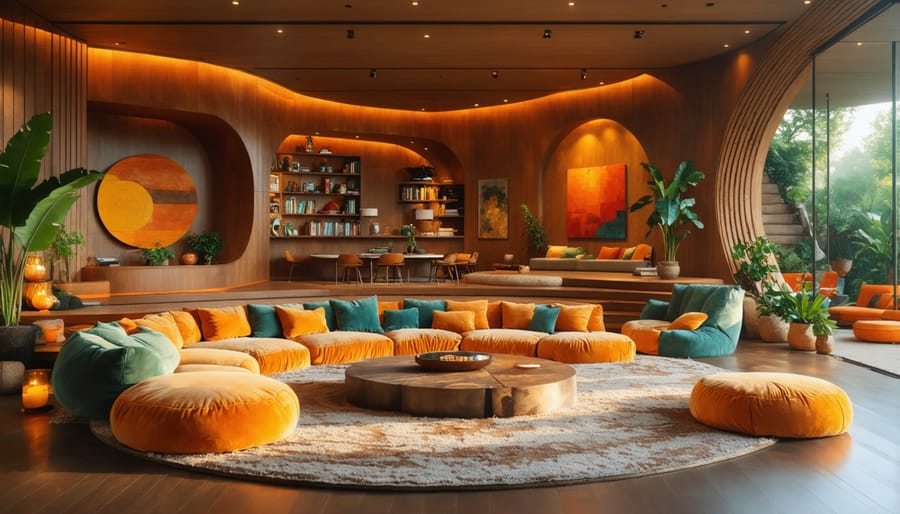
Bring Back That Groovy Vibe: 70s Home Decor That’s Making a Bold Comeback
Step into the bold, expressive world of 1970s interior design, where sunburst mirrors meet shag carpets and earth-toned wallpaper creates the perfect backdrop for macramé plant hangers. This iconic decade’s vintage design ideas are experiencing a remarkable renaissance, with modern homeowners embracing its distinctive blend of organic shapes, rich textures, and fearless color combinations. The 70s weren’t just about style – they represented a cultural shift toward self-expression and environmental consciousness that resonates powerfully with today’s design sensibilities. Whether you’re looking to create an authentic retro haven or simply incorporate nostalgic touches into your contemporary space, the 70s offer a treasure trove of inspiration that feels both timeless and surprisingly fresh. From statement-making conversation pits to the warm glow of mushroom lamps, these defining elements of 70s décor continue to captivate and inspire, proving that great design truly never goes out of style.
Iconic Colors of the 70s
Earth Tones and Warm Neutrals
The 1970s palette was dominated by rich earth tones that brought the natural world indoors. Warm browns, from deep chocolate to lighter tan, formed the foundation of many living spaces. These were often paired with burnt orange, a signature color that appeared on everything from shag carpets to accent walls. Harvest gold, another iconic shade of the era, added a touch of warmth and sophistication to kitchens and living rooms through appliances, curtains, and upholstery.
These earthy hues weren’t just random choices – they reflected the decade’s growing environmental awareness and desire to create cozy, grounded spaces. Rust browns and terracotta oranges brought a desert-inspired warmth, while amber and golden tones added a subtle glow to rooms. The combination of these colors created layered, dimensional spaces that felt both sophisticated and inviting.
Today, these vintage earth tones are making a strong comeback, albeit in more balanced proportions. Modern designers often incorporate these classic shades through accent pieces, textiles, or statement walls, rather than the full-room coverage typical of the 70s.
Bold and Psychedelic Colors
The 1970s brought an explosion of vibrant colors that defined an era of bold self-expression in home décor. Avocado green dominated kitchens and bathrooms, while harvest gold made its mark on appliances and wall coverings. These weren’t just random choices – they reflected the decade’s embrace of nature and organic living. Sunshine yellow, burnt orange, and deep brown created dramatic color combinations that might seem overwhelming by today’s standards but perfectly captured the era’s psychedelic spirit.
Living rooms often featured bold geometric patterns in purple and green, while bedrooms came alive with hot pink and electric blue. Wood paneling served as a perfect backdrop for these adventurous color choices, creating a warm, earthy foundation that balanced the more daring hues. The beauty of these vintage palettes lies in their fearless approach to color mixing – something we can still learn from today. Whether you’re looking to fully embrace the 70s vibe or just add a touch of retro flair, incorporating these bold colors can instantly transport your space back to this vibrant decade.
Signature Furniture Pieces
Conversation Pits and Sunken Living Rooms
Few architectural features epitomize 1970s interior design quite like the conversation pit and sunken living room. These cozy, recessed spaces were the ultimate expression of casual entertaining and laid-back luxury. Typically designed a few steps below the main floor level, these areas featured built-in seating wrapped around a central focal point, usually creating a perfect square or circle.
The conversation pit was more than just a design choice – it was a social statement. These sunken spaces encouraged face-to-face interaction in an era before smartphones and social media. Plush carpeting, oversized cushions, and often a central fireplace created an intimate atmosphere perfect for cocktail parties and casual gatherings. For more inspiration on adding cozy and stylish elements, explore cozy decor ideas that can enhance your space.
While original conversation pits can still be found in preserved mid-century homes, modern interpretations have begun appearing in contemporary architecture. Today’s versions often incorporate updated materials and practical considerations, like built-in USB charging stations and modular seating arrangements.
For homeowners interested in recreating this vintage feature, there are several approaches. Some opt for partial steps down with modern sectional sofas, while others create the illusion of a sunken space using strategic furniture placement and area rugs. The key is maintaining the original concept’s intimate feel while adapting it to today’s lifestyle needs.
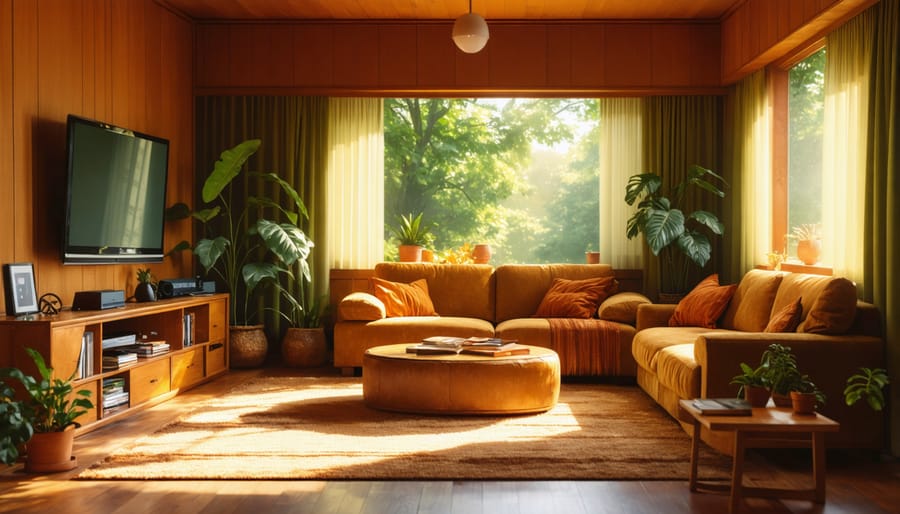
Statement Seating
The 1970s revolutionized casual seating with designs that perfectly balanced comfort and style. Bean bags emerged as the ultimate relaxation spot, offering a laid-back vibe that defined the era. Available in vibrant colors and various materials, from vinyl to corduroy, these adaptable seats became a staple in every groovy living room.
Papasan chairs, with their distinctive bowl-shaped rattan frame and plush cushions, brought an exotic touch to 70s homes. These versatile pieces could be easily dressed up with colorful cushions or throws, making them both a statement piece and a cozy reading nook. Today, vintage papasan chairs are highly sought after, though modern reproductions capture the same free-spirited essence.
Perhaps the most revolutionary seating innovation of the 70s was the modular sofa. These customizable pieces allowed homeowners to create their perfect seating arrangement, with sections that could be rearranged at will. Often upholstered in bold patterns or rich earth tones, modular sofas exemplified the decade’s emphasis on functionality and social gathering.
To incorporate these iconic seating options into your modern space, consider mixing vintage pieces with contemporary elements. A classic bean bag in a neutral tone can add whimsy to a reading corner, while a restored papasan chair makes for an eye-catching accent piece. For larger spaces, today’s modular sofas offer the same versatility with updated materials and improved durability. You can also explore options with free delivery for convenience by checking out beds and futons that complement a vintage-inspired space.
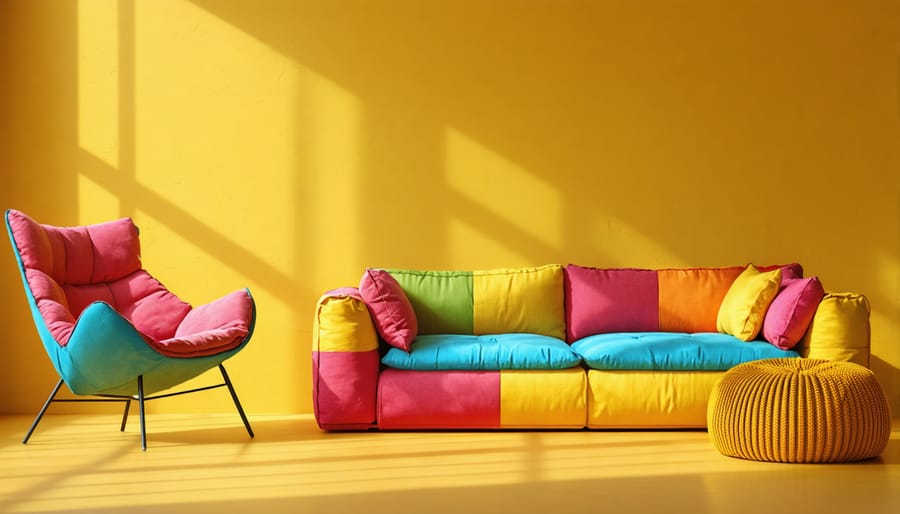
Materials and Textures
Shag Carpeting and Textiles
Shag carpeting defined the 1970s interior landscape, with its luxuriously deep pile and bold color choices making it the ultimate statement piece in any room. Homeowners embraced these plush textiles in vibrant oranges, browns, and golds, often covering entire floors from wall to wall. The signature deep-pile carpet wasn’t just limited to floors – some adventurous decorators even extended it to walls, creating cozy, sound-dampening spaces that epitomized the era’s commitment to comfort.
Beyond shag carpeting, the ’70s saw an explosion of textural fabrics throughout the home. Chunky woven wall hangings, macramé plant holders, and velvet upholstery added layers of visual and tactile interest. Geometric patterns and nature-inspired prints dominated fabric choices for curtains and throw pillows, often featuring earthy color palettes or psychedelic designs.
For today’s homes, modern interpretations of these textile choices offer more practical solutions. Consider area rugs with a shorter shag pile for easier maintenance, or incorporate vintage-inspired geometric patterns through accent pillows and throws. Contemporary versions of macramé and woven wall art provide texture without overwhelming a space, while performance fabrics with retro patterns offer durability without sacrificing style. The key is finding balance between ’70s flair and modern functionality.
Wood Paneling and Natural Elements
Wood paneling was perhaps the most iconic feature of 1970s home interiors, with rich, dark woods dominating walls and furniture pieces. Natural materials weren’t just a design choice – they were a lifestyle statement that reflected the era’s growing environmental consciousness and desire for authenticity.
The most popular wood treatments included floor-to-ceiling panels in warm tones like walnut and oak, often with distinctive vertical grooves. These panels weren’t limited to living rooms; they made their way into dens, basements, and even kitchens. Homeowners particularly favored pine and cedar for their aromatic qualities and rich graining patterns.
Beyond wood paneling, natural elements appeared everywhere in 70s homes. Exposed ceiling beams, bamboo room dividers, and woven rattan furniture pieces were staples of the decade. Macramé plant hangers displaying trailing pothos and spider plants added an organic touch, while cork walls served both decorative and functional purposes in home offices and children’s rooms.
For a modern take on this trend, consider installing accent walls with wood paneling or incorporating smaller wooden elements like floating shelves and picture frames. Today’s designers often pair original 70s wood features with contemporary colors and materials for a balanced, updated look that honors the era’s natural aesthetic.
Iconic Decor Elements
Patterns and Prints
The 1970s brought an explosion of bold patterns and prints that defined the era’s distinctive aesthetic. Geometric patterns dominated walls and furnishings, featuring repeating shapes like hexagons, circles, and zigzags in striking color combinations. These dynamic designs often incorporated traditional decor elements with a groovy twist, creating spaces that felt both familiar and revolutionary.
Wallpaper emerged as a dominant feature, with large-scale floral prints being particularly popular. These weren’t your grandmother’s delicate flower patterns – 1970s florals went bold with oversized blooms in vibrant oranges, browns, and yellows. Abstract designs featuring psychedelic swirls and organic shapes added movement and energy to interior spaces.
Earth-toned patterns drew inspiration from nature, incorporating leaf motifs, sunbursts, and mushroom designs. These patterns appeared on everything from curtains to upholstery, often layered together in what we’d consider a daring mix today. Foil wallpapers brought metallic elements into the mix, featuring damask patterns and abstract designs that caught and reflected light.
The period’s signature pattern style extended beyond walls to textiles, with shag carpets featuring geometric designs and curtains showcasing bold stripes or abstract prints. Many of these patterns are making a comeback in modern homes, albeit in more subdued color palettes or as accent pieces rather than full-room applications.
Accessories and Art
The 1970s brought an explosion of natural textures and handcrafted elements into home decor, with macramé leading the charge as the decade’s signature craft. These intricate rope and cord creations appeared everywhere, from plant hangers to wall hangings, adding organic warmth to living spaces. Hanging plants became a must-have accessory, with spider plants and pothos cascading from macramé holders in sunny corners and window nooks.
When it came to wall art, the 70s didn’t hold back. Large-scale woven tapestries, often featuring earth-toned geometric patterns or nature scenes, dominated living room walls. Sun-themed mirrors and metal wall sculptures added a characteristic bohemian touch, while framed psychedelic posters brought bold colors and trippy patterns into bedrooms and dens.
Cork boards and bamboo shelving units provided practical display space for collections of small artifacts, from carved wooden figures to handmade pottery. String art created striking geometric patterns using colored thread wrapped around nail patterns, while pressed flowers in simple frames brought the outside in. These decorative elements weren’t just accessories – they were expressions of the era’s free-spirited, nature-loving attitude and DIY ethos, elements that continue to inspire modern vintage enthusiasts today.
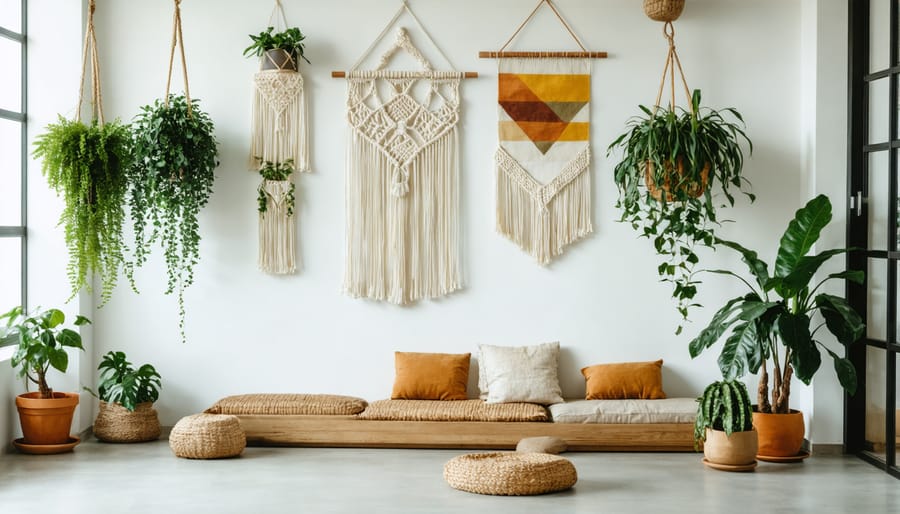
Modern Integration Tips
Bringing 70s style into your modern home doesn’t mean you have to go full-on Brady Bunch. The key is to select signature pieces and blend them thoughtfully with contemporary elements. Start with a statement piece, like a sunburst mirror or a bold geometric area rug, and build around it with modern furnishings.
Color is your best friend when integrating vintage vibes. Instead of covering entire walls in intense oranges or avocado greens, use these classic 70s hues as accent colors through throw pillows, artwork, or a single painted feature wall. This creates impact without overwhelming your space.
Plants are essential to the 70s aesthetic and work perfectly in modern homes. Choose large-leafed varieties like monstera or rubber plants in contemporary planters to bridge the decades. Macramé plant hangers offer an authentic touch while remaining surprisingly current.
When it comes to furniture, look for pieces with characteristic curved lines and plush textures. A vintage velvet armchair can become a stunning focal point in a modern living room. For a subtle nod to the era, incorporate rattan or wicker accessories like pendant lights or side tables.
Mix materials strategically – pair shag pillows with sleek modern sofas, or place a chrome and glass coffee table on a traditional Persian rug. Don’t forget about lighting; swap out standard fixtures for pendant lights with smoked glass or geometric shapes to add instant 70s flair without compromising your home’s contemporary feel.
Remember, successful integration is about balance. Choose two or three 70s elements per room rather than recreating an entire vintage space. This approach ensures your home feels current while celebrating the best of this iconic decade.
The vibrant spirit of 70s home decor continues to captivate and inspire modern interior design. From the warm earth tones and bold geometric patterns to the fascinating mix of natural materials and funky accessories, this iconic era offers endless possibilities for contemporary spaces. Whether you choose to go all-out with a complete 70s transformation or simply incorporate select vintage pieces, the key is to embrace the era’s playful creativity while adapting it to your personal style. Don’t be afraid to experiment with macramé wall hangings, bold wallpapers, or retro furniture pieces – the 70s were all about self-expression and breaking design rules. By thoughtfully blending these vintage elements with modern amenities, you can create a unique living space that honors the past while remaining thoroughly functional for today’s lifestyle.
